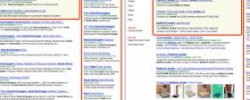- Ad tag – Typically served as javascript through a website’s ad server, an ad tag allows a website to communicate with an ad partner and serve an appropriate ad
- Ad exchange – an ad partner that serves as a broker between a publisher and an advertiser. Ad exchanges use RTB technology to sell a publisher’s inventory in an auction-like manner. Typically, you can set a price floor within an ad exchange and you’ll receive a higher rate due to the auctioning process.
- Ad network – an ad partner that serves as a middle man between a publisher and an advertiser. Typically, ad networks provide you with a static rate for your inventory that rarely fluctuates.
- Auction Price Floor – This is the same idea as a standard price floor but in an auction or programmatic environment the floor serves as a minimum but can be exceeded by higher bidding. For example if you set your price floor at $1 you can still receives bids at $1.25 but not $.75.
- Creative – You will often here this word used to refer to the actual images the advertising display
- Daisy chain (Ad chain) – Placing ad partners ad tags in order (usually by CPM rate, highest to lowest) so they have the option of serving an ad or ‘defaulting’ to the next partner in line.
- Discrepancy – In digital advertising this refers to the difference between client number (typically taken from an ad server) and ad partner numbers. These differences are caused by a variety of factors including the number of partners you’re working with, the individual user you’re serving ads to, and page load time. Standard discrepancy metrics are impressions sold, served, revenue.
- DSP (Demand Side Platform) – A buy side platform that allows buyers of digital ad inventory to easily and more directly connect with sellers in a programmatic and real time environment
- Fixed CPM – A CPM rate that remains constant and is guaranteed by an ad partner for every 1, 000 impressions that are sent.
- IAB (The Interactive Advertising Bureau) – Made up of over 500 leading media and technology companies, IAB works to educate about the value of interactive advertising as well as evaluate and recommend standards and practices (such as standard unit size).
- Iframes – an HTML document embedded within another HTML document that allows content from another source to appear on a web page.
- Passback tag (Default tag) – When an ad partner chooses to pass on the opportunity to capture or serve an ad impression they ‘default’ the opportunity to serve an ad. The tag that’s called during that default process is referred to as a passback tag.
- Price Floor – A fixed CPM rate that prevents an ad partner from serving campaigns that pay below a certain price threshold. For example, if you set your price floor to $1 your ad partner shouldn’t serve any campaigns with net CPM rates below that amount.
- Revenue share model – A partnership between a publisher and ad provider where profits from ad serving are split as per the terms of the agreement. Before the rise of programmatic and RTB these agreements were closer to 50/50, but with the rise of programmatic buying that split has increased in the publishers favor. For example, Google’s Ad Exchange offers a 80/20 revenue share. These rates are often negotiable depending on how much volume a publisher can provide.
- RFP (Request for Proposal) – A request from an advertiser, brand, or media agency for a publisher to submit a bid to win their business for an ad campaign. A RFP typically outlines rates, time, cost, technical specs, audience and units.
- RTB (Real Time Bidding) – Impression based, real time ad inventory sales method. This is a technology that allows thousands of buyers to bid on a single website impression based on bidding algorithms.
- SSP (Supply Side Platform) – A sell side platform that allows publishers to better package and manage their websites inventory to sell.
- Viewability – A new metric for measuring performance created by the 3MS initiative (Making Measurement Make Sense), and authorized by the MRC (Media Rating Council). Viewability was created to ensure an advertiser that a brand will be viewed by a user. The MRC declared a viewable impression as “at least 50% of the ad creative is displayed for at least 1 second.”
- Volume – Refers to how much traffic (impressions/pageviews) a website has over a given period of time. Ad partners will often ask how much volume a publisher is willing to send at a discussed rate.
Ways to buy/sell advertising inventory:
- CPA (cost-per-action) or CPL (cost-per-lead) – “Action” or “Lead” mean exactly that; some type of action or lead resulted from the display of the ad such as a sale or registration obtained.
- CPC (cost-per-click) – Yes, you guessed it; this would be the amount paid every time someone clicks on an advertisement.
- CPM (cost-per-milli) – From the Latin meaning one thousand. Literally, the amount paid for every 1, 000 qualifying impressions served.
- eCPM (effective cost per milli) – This term gets more specific and shows the cost of ad inventory based on the amount of impressions that were actually shown/paid. Here is the formula to determine this amount: eCPM = Revenue/(Paid Imps/1000)
- rCPM (real cost per milli) – The most accurate view of ad space of the three, this provides the “real” worth because it takes into account the total imps that occurred, not just the ones that paid, which is important when determining the value of a space. The formula to determine this amount is: rCPM = Revenue/(Total Imps/1000)








